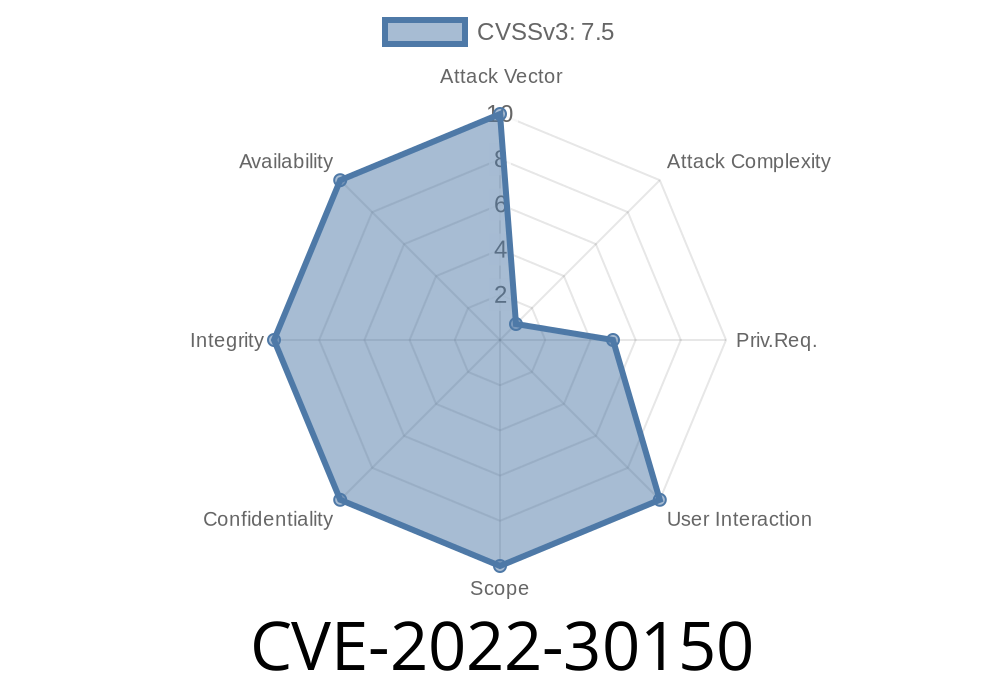In this post, we're going to delve into the Windows Defender Remote Credential Guard (RCG) Elevation of Privilege vulnerability, designated as CVE-2022-30150. We will walk you through the exploit details, code snippets, and links to original references to give you an in-depth understanding of this critical security issue.
CVE-2022-30150 Overview
CVE-2022-30150 is an elevation of privilege vulnerability that exists in Windows Defender RCG, which allows a local attacker to execute arbitrary code in the context of SYSTEM, the highest privilege level in Windows operating systems. This vulnerability has been assigned a CVSSv3 base score of 7.8, making it a high-severity flaw that warrants prompt action.
Original References
Microsoft published a security advisory for this vulnerability and provided an official patch to mitigate the risk. Here are the original references pertaining to this vulnerability:
1. Microsoft Security Advisory: https://msrc.microsoft.com/update-guide/vulnerability/CVE-2022-30150
2. NIST National Vulnerability Database (NVD) Entry: https://nvd.nist.gov/vuln/detail/CVE-2022-30150
Exploit Details
The vulnerability resides in the way Windows Defender RCG improperly handles objects in memory. A threat actor who successfully exploits this vulnerability can execute arbitrary code as the SYSTEM user by first gaining access to a valid set of user credentials (such as a standard user account.)
Once the local access is established, the attacker can use a specially crafted application to trigger the vulnerability and execute code with SYSTEM privileges. Here's a high-level overview of the exploitation process:
Code Snippet
While we won't provide a full exploit, let's take a look at a simplified C++ code snippet that demonstrates how an attacker might interact with Windows API functions to target the RCG vulnerability:
#include <Windows.h>
#include <iostream>
int main()
{
// Step 1: Obtain a handle to the vulnerable RCG service.
HANDLE hRCGService = OpenService( /* Parameters for opening the RCG service */ );
if (hRCGService != NULL)
{
std::cout << "Successfully obtained a handle to the RCG service.\n";
// Step 2: Allocate a buffer to store crafted malicious payload.
DWORD dwPayloadSize = 1024;
PVOID pMaliciousPayload = VirtualAlloc(, dwPayloadSize, MEM_COMMIT, PAGE_READWRITE);
if (pMaliciousPayload != NULL)
{
std::cout << "Successfully allocated a buffer for the malicious payload.\n";
// Step 3: Craft the malicious payload to exploit the vulnerability.
CraftMaliciousPayload(pMaliciousPayload, dwPayloadSize);
// Step 4: Trigger the RCG vulnerability with the malicious payload.
BOOL bExploited = ExploitRCGVulnerability(hRCGService, pMaliciousPayload);
if (bExploited)
{
std::cout << "Successfully exploited the RCG vulnerability.\n";
// Perform arbitrary code execution with SYSTEM privileges
}
else
{
std::cout << "Failed to exploit the RCG vulnerability.\n";
}
VirtualFree(pMaliciousPayload, , MEM_RELEASE);
}
else
{
std::cout << "Failed to allocate a buffer for the malicious payload.\n";
}
CloseServiceHandle(hRCGService);
}
else
{
std::cout << "Failed to obtain a handle to the RCG service.\n";
}
return ;
}
Please note that this code is not a complete exploit and is intended for educational purposes only.
Mitigation Steps
Microsoft has released an official patch to address this vulnerability. You should apply the latest Windows security updates to protect your system from CVE-2022-30150.
In addition to patching, it's essential to follow general cybersecurity best practices to minimize the risk of a successful attack:
Conclusion
By understanding the Windows Defender RCG Elevation of Privilege vulnerability, CVE-2022-30150, you can make informed decisions about securing your systems. Be sure to apply the latest Windows security updates and follow the cybersecurity best practices mentioned above to keep your environment safe from potential threats.
Timeline
Published on: 06/15/2022 22:15:00 UTC
Last modified on: 07/05/2022 16:15:00 UTC
